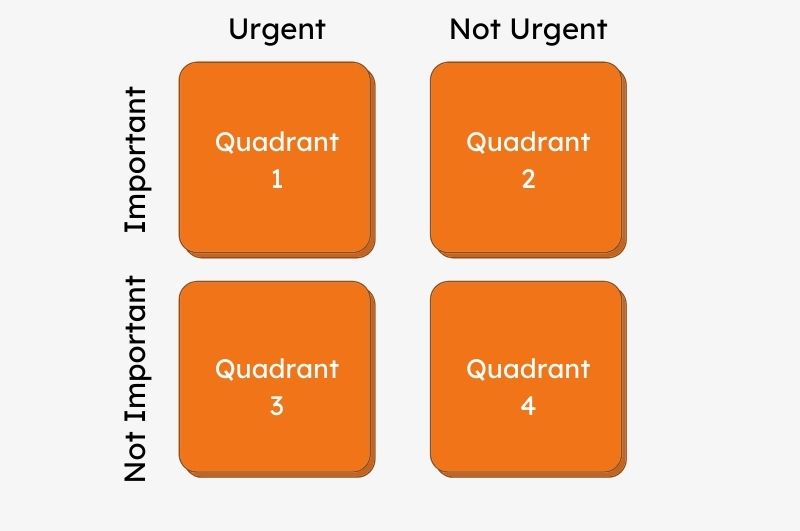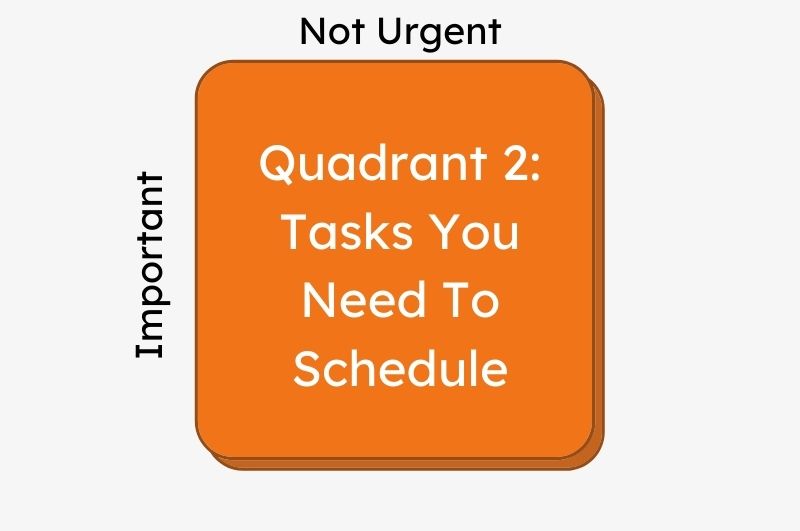A time management matrix system could be your ticket to a more productive and less stressful life. You have likely tried to use other time management systems before, but it is doubtful that you have run across anything as powerful as this. Let’s explore the time management matrix and how you can utilize it.
What is a Time Management Matrix?
Steven Covey is credited with first coming up with the time management matrix in his famous book “The 7 Habits of Highly Effective People“. This book remains a best-seller, and it is often looked upon with reverence by those who have seen it work wonders in their own life. The concepts in the book are so well-known and influential that they are often used by business leaders and individuals who desire to inspire others and manage time effectively.
The concept behind the time matrix is relatively straightforward. It is meant to be used to identify the most urgent tasks that a person has to do. They can tackle those tasks before moving on to the more challenging issues they are sure to face. It is meant to help push the most pressing matters to the forefront so they can be identified and completed before moving on.

A time management matrix is a helpful tool in determining which tasks need to be completed first but also in weeding out tasks that don’t need to be bothered at all. It is common for us to allow specific tasks to get buried deep into our brains and override our sense of what matters regarding productivity. We may find ourselves stressing over assignments that only add a little to our day. The time matrix can help us sort this out.
Everyone is welcome to use this time-saving strategy for themselves. Some groups of people that have found it helpful include:
- Teachers
- Business leaders
- Students
- Creative Types (Artists, Writers, Musicians, Etc.)
- Busy Parents
Anyone with a plan of tasks they need to accomplish may discover something useful for them within this time management system. If you are tired of constantly feeling behind on your tasks, then the time to explore what this system can do for you is undoubtedly right now.
How Can You Use a Time Management Matrix?
Now that you know a little about the matrix, you need to know how to implement it in your own life. The very first thing you want to do is get organized. This means getting a piece of paper and a utensil and writing out all the tasks you feel you need to accomplish for the week. You don’t have to write them down in any particular order at this stage; you need them all written on paper.

Once your list is complete, you will likely see a big mess of various tasks you would like to accomplish. You should know this when you first start using this system, so don’t let this overwhelm you. You will look over that list to see which tasks are most urgent and important. For example, getting a speeding ticket paid is something that you know you need to take care of immediately. However, you should create a separate list for less important tasks.
From there, you keep going down the list, separating tasks by order of importance. You might have some mid-tier tasks that need to come next, and then you might have some tasks that could be more important to finish now. It is perfectly acceptable to have a list like this as long as you know that the tasks will need to be split into various categories before you can plunge into working on them. Once you have this all on paper, you can start the diligent work of splitting up these tasks into sub-categories that will make the matrix come to life and help you accomplish time management goals.
You will need to split the tasks into 4 quadrants of time management to see where each task fits into your plans for the day. We will break these quadrants down one by one for you now.
Quadrant 1: Urgent and Important
The essential tasks go into this first quadrant and should be the first tasks that you take on for the day. When you see this list of tasks, you will immediately know which ones they are because these are the tasks that have likely been reaching your attention for a very long time.

They are the things that will cause your entire day to fall apart unless you don’t get them done. Precisely what these tasks are will vary depending on the person setting up the time management matrix, but they will always be essential.
Think about a busy parent and what their matrix may look like. For them, they may put tasks such as the following in their Quadrant 1:
- Pick up the kids from school
- Pay the utility bill
- Make sure school lunches are ready to go out for tomorrow
These priorities must be completed for the day to go on as planned. They are also tasks likely to look different from what a business leader might put into their Quadrant 1. The difference is that these are two very different types of people. However, they both still have priorities that need to be accomplished before they move on to the next thing. One set of objectives is more important than the other. Instead, it is to point out that everyone has their own set of priorities, and getting those priorities straightened out is important.
Quadrant 1 is where all your energy should be channeled until it is complete. Once you have moved through the entire cycle of tasks in Quadrant 1, you can even think about additional tasks to be completed in the other quadrants. The sense of accomplishment one gets from finishing their Quadrant 1 tasks is enormous and can carry them through finishing their other tasks.
Quadrant 2: Not Urgent But Important
Almost everyone has some tasks they know to be important in life, but they may not be the most urgent thing in the world.

This is because life gets stacked up with various chores we have to handle, but they only sometimes rise to the level of being entirely urgent. This is why we need to be aware of those tasks so they can go into a quadrant of their own.
The tasks that go into Quadrant 2 are still essential to accomplish, but the time limit on them is not necessarily today. Thus, you are not necessarily under the same pressure that you might be with some of your Quadrant 1 tasks, but you are still well aware that this quadrant is among the most important of the 4 quadrants of time management.
In this case, we might look at what a business leader would put in their Quadrant 2. This might include:
- Preparing a presentation that isn’t due for months
- Putting a morale booster program together
- Reviewing financial numbers relevant to a report due some time down the road
You can see that each of these tasks needs to get done, but each has an extended time frame that you wouldn’t necessarily find with Quadrant 1 tasks. That is why these missions can come to rest in Quadrant 2.
It is optional to do these tasks right away. It is recommended to schedule Quadrant 2 tasks and do them only when the time comes.
Quadrant 3: Urgent But Not Important
How can a task be urgent but not important? Simple, when the task is something you need to get done, but that doesn’t add value to your day.

In other words, if the task has a time limit but doesn’t necessarily add much value to your day, then it can be a Quadrant 3 task.
Many people have a hard time picturing what a task that qualifies for Quadrant 3 status would look like, and that is why we wanted to provide some examples:
- Eliminating the spam e-mails from your inbox
- Creating a new logo for a project that may be used someday
- Submitting your picks for a fantasy football contest
Each of these tasks is something you would benefit from in some way, and they may even have a time limit set on them, but you don’t have to stress them too much. If you get around to them during your day, significant, but it’s not the end of the world if you don’t.
Quadrant 4: Neither Urgent Nor Important
You have to wonder why you would include tasks that are neither urgent nor important to your quadrant.

The truth is, we all know that some of these tasks are the ones that we cannot get out of our heads. It seems they buzz around until we can finally accomplish the task or determine it is not worth it.
A task that is neither urgent nor important can still be included in the time management matrix. You can still put these tasks into the matrix if for no other reason than you want to make sure you understand where your priorities lie.
A few examples of what a quadrant 4 task might look like include:
- Look up the latest celebrity gossip
- Planning a shopping trip
- Take cute pictures of your pets
- Posting on social media
- Writing texts back to friends
These are pleasant thoughts, but you don’t have to rush out and take care of them immediately. It is up to you when these tasks get done (if at all), but you still want to keep them on your list so that you know they still need to get done.
What are the Benefits of Using a Time Management Matrix?
You don’t have to worry much about time management when you have everything written down in the matrix. You will know precisely how you are supposed to allocate your time and which tasks you can put off until a later date. There is something freeing about setting yourself up with these dynamics and allowing the chips to fall freely. You may experience lower levels of stress by just knowing that everything you need to accomplish is put together in little boxes.
Everyone recognizes the benefits of knowing they will get a surge of motivation by knocking off their Quadrant 1 tasks first and then moving on to the things that are less urgent or important. Freeing yourself up so you can focus your full energy on those lesser tasks is a huge deal.
Who Can Use the Time Management Matrix?
I do not think only business leaders can use the time management matrix for a moment. It is built to be used by everyone. If you have a business schedule that you are dealing with, then the time management matrix is for you. If you are overwhelmed by the piles of work stacking up before you, this one is for you. If you could better use your time and resources to accomplish more important things in your life, this is for you. Students love the time matrix, as do teachers, busy parents, small business owners, and those trying to give their creative talents a boost. In short, no one can’t benefit from the time management matrix in some form or fashion.
Examples of Time Management Matrix
Let’s pull this all together now. What does a completed time management matrix look like, and how can you start to form your own?
As stated above, the first step towards a completed time management matrix is to get all the tasks you have to handle written out on paper so you can see exactly what is taking up space in your brain. After that, you will immediately start to categorize each task into one of the 4 quadrants of time management. You need to be very honest with yourself at that moment so that you are not putting anything into a category in which it doesn’t belong. If your heart is telling you that a task is not urgent or important, that is probably the case.
After you have everything written out, slide those tasks into the quadrants. Expect to get it differently than the first time!
This is something that takes some time and practice to get right. You don’t want to convince yourself that you should be perfect from the start. This is an unrealistic expectation, and it will probably lead to you getting very discouraged when things go wrong. Instead, try to understand that a process of trial and error may be necessary until you have worked out all of the potential glitches with the plan.
Let’s take a look at what a completed matrix might look like for a creative person who is attempting to expand their writing career:
Quadrant 1:
- Complete assignments that are on deadline
- Submit invoices for payment
Quadrant 2:
- Update writer profile
- Submit applications for multiple writing websites
- Pitch new clients
Quadrant 3:
- Look for local writing competitions to submit work to
- Discover magazines that may be currently looking for submissions
Quadrant 4:
- Purchase a new office desk for writing purposes
- Clean up the office for maximum productivity
Conclusion
As you can see, each quadrant has items listed in it that would be nice to take care of, but each is only given the priority and respect it deserves. The Quadrant 4 tasks are much less important than the Quadrant 1 tasks, which is why they have been listed in the ways they have. The writer who has their matrix set up this way will likely get a lot done and ensure they stay on track with all their goals. It is important to look over these quadrants regularly and ensure that they still serve your purposes. It is all about accomplishing more in the same amount of time.


